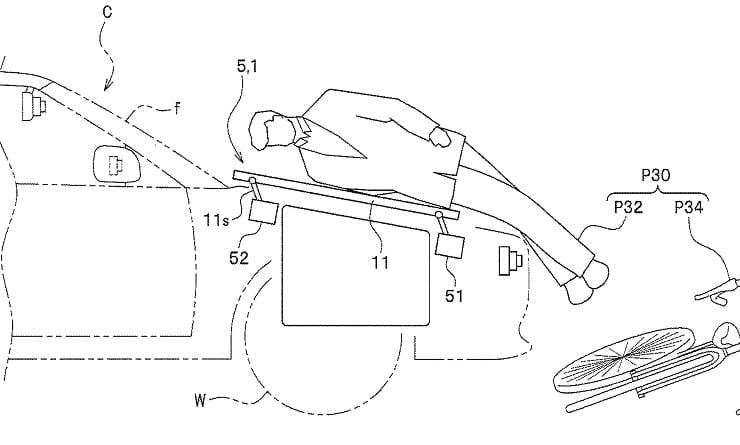External airbags could be fitted to cars as early as 2021
By Ben Purvis
Motorcycle Journalist
20.04.2020
Jeremy Clarkson once said “Speed has never killed anyone. Suddenly becoming stationary, that's what gets you.” It’s a variation on the old adage that it’s not the fall but the sudden stop at the bottom that hurts, but it’s never truer than during a bike crash.
Come off at 180mph on a race track, wearing the right kit and with plenty of run-off area to slide into, and there’s a good chance you’ll walk away. Hit something hard and immovable at a fraction of that speed and the outcome is likely to be far worse.
It’s something that car makers have understood for decades. Airbags, crumple-zones and seat belts exist solely to stop those sudden stops and have achieved wonders in reducing the deaths and injuries of those travelling inside modern cars but there’s been noticeably less progress in protecting those on the outside.
Now, though, there’s an increasing amount of work going into the idea of putting airbags on the outside of cars to protect pedestrians, cyclists and motorcyclists.
Honda has shown a particular interest recently, filing a host of new patent applications for systems designed to protect the soft, squishy people – whether on foot or on two wheels – on the outside of a car during an accident.
The patent ideas have revolved around not only external airbags but a system that uses radars, cameras and computers to recognise exactly what the car is about to hit, assess how big it is and to adjust the car’s reaction to minimise injuries.
As well as external airbags the Honda ideas include a variety of movable panels, including bonnets that rise up and alter their angle to cushion the impact, and even low-level bumpers that extend at ankle height to push a pedestrian’s feet away and make sure they’re flipped up onto the bonnet instead of going under the car.
Other patents even show specially-shaped airbags that are designed to wrap around a pedestrian, cyclist or motorcyclist who finds themselves on the car’s bonnet, holding them in place so they aren’t bounced off into a secondary impact with the ground or other traffic.
Honda isn’t alone in this avenue of research. German parts supplier ZF has developed a set of side-mounted airbags for cars that can mitigate injuries in side-on impacts of the sort you might expect if a car pulled out in front of you.
First demonstrated in late 2018, the bags are similar to Honda’s idea in that they’re tied into an array of radar, camera and LiDAR sensors that help register whether there’s going to be an impact and help a central computer decide if it should deploy the bags. They’re extended in less than 100 milliseconds once the computer gives the go-ahead, which means they can be fully inflated before the crash actually starts.
Unlike the Honda external airbag ideas, which are focussed on protecting vulnerable road users outside the vehicle, the ZF bags’ main focus remains the occupants of the car they’re fitted to, helping disperse energy as the car is hit and reducing the chances of intrusions into the car’s cabin. However, a soft, energy-absorbing airbag is sure to be less damaging to motorcyclist than the hard bodywork of a car.
ZF reckons the bags could be fitted to production cars as early as 2021.
It’s notable that all these ideas of external airbags revolve around the fitment of far more sensors to monitor the movement of vehicles and objects outside the cars that are using them.
It might well turn out that the proliferation of sensors, rather than the airbags themselves, will turn out to be the real game-changer. We’re already seeing many modern cars fitted with accident-mitigating automatic braking systems – in fact, a car now needs crash-avoidance technology to get a Euro NCAP five-star crash rating – and by adding additional sensors and computers that build a more complete picture of a car’s environment, cars with external airbags will actually be better equipped to avoid crashes in the first place.
Of course, no level of technology will be able to fully replace good observation and quick, correct reactions on the part of both drivers and riders – at least, not yet – but anything that adds another layer of protection between motorcyclists and increasingly cocooned car drivers has got to be welcome.
It’s notable that all these ideas of external airbags revolve around the fitment of far more sensors to monitor the movement of vehicles and objects outside the cars that are using them.
It might well turn out that the proliferation of sensors, rather than the airbags themselves, will turn out to be the real game-changer. We’re already seeing many modern cars fitted with accident-mitigating automatic braking systems – in fact, a car now needs crash-avoidance technology to get a Euro NCAP five-star crash rating – and by adding additional sensors and computers that build a more complete picture of a car’s environment, cars with external airbags will actually be better equipped to avoid crashes in the first place.
Of course, no level of technology will be able to fully replace good observation and quick, correct reactions on the part of both drivers and riders – at least, not yet – but anything that adds another layer of protection between motorcyclists and increasingly cocooned car drivers has got to be welcome.
Share on social media:

